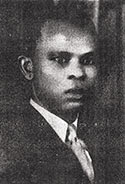Dr. Rupert O. Roett
Born on December 15, 1887, Roett left his home in Barbados West Indies at the age of 33 and came to the United States to attend the School of Divinity at Howard University in 1910. After a year of courses there, he enrolled at Meharry Medical College in Nashville and earned his M.D. degree in 1915. He spent the next three years completing his internship and residency at Tuskegee Institute in Alabama, where he worked at John A. Andrews Hospital, served as its first president, and helped to organize the John A. Andrews Clinical Society.
Having heard about the opportunities available on the West Coast, Dr. Roett decided to head for California in 1918, but he never made it to his intended destination. He said he “was just passing through” when he stopped in the rapidly developing town of Houston during his travels. While visiting, he met several other young, ambitious black physicians, including B.J. Covington, Charles Jackson, F.F. Stone, and Henry E. Lee. These four men persuaded Dr. Roett to stay in Houston and help them build a black hospital for the city.
“I was appalled to discover that the city had no medical facilities where black doctors could practice medicine and treat their patients. Blacks had to travel to Galveston to be treated for their diseases and sicknesses,” Dr. Roett remembered. The doctors’ efforts paid off and they opened Union Hospital, which had six beds and a small surgery room in a house at the corner of Nash and Howard Streets. Union Hospital was soon overcrowded with patients, so in 1923, Dr. Roett and his colleagues moved their hospital facilities to a new, larger building they named the Union-Jeremiah Hospital (after the man who had constructed the building a year earlier). Dr. Roett was one of the first doctors to realize the need for separate ward facilities for different types of patients. “We had individual wards for women, men, children, and recovery patients,” he recalled. “It was a rather revolutionary idea in the practice of hospitalization.”
With a three-acre donation of land from the city of Houston and $80,000 from oilman Joseph S. Cullinan, in 1926 the Houston Negro Hospital, a fifty-bed ward hospital, was built at the present site of Riverside General Hospital. Dr. Roett became one of the leading physicians there and was an integral part of the hospital’s development over the years. Even after developing a large and lucrative practice, each night he went by the hospital to see “how things were getting along.” He remained on the staff at Riverside until the early 1960s.
Dr. Roett was active in professional organizations, including the National Medical Association, where he served as the only Texan on the executive board of trustees for several years, and the Houston Medical Forum, of which he was the president for a term in the 1920s. He was married to the former Catherine Bryant for 50 years and they had two children, Rupert, Jr., and Catherine, who was Houston’s first black pediatrician. He died around the end of the 1970s. Dr. Roett’s dedication and determination in the early days of Houston’s growth set the standard for a steady course of progress that continued at Riverside General Hospital throughout the subsequent decades.
Next Biography: Dr. JoAnne Rogers
Return to: Houston’s Union Hospital
Return to: Meharry and Howard


